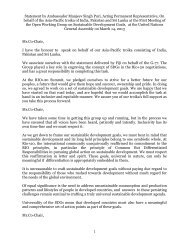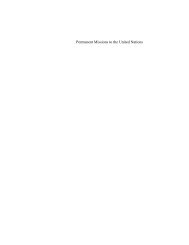STATE OF THE WORLD'S CITIES 2012/2013 Prosperity
STATE OF THE WORLD'S CITIES 2012/2013 Prosperity
STATE OF THE WORLD'S CITIES 2012/2013 Prosperity
Create successful ePaper yourself
Turn your PDF publications into a flip-book with our unique Google optimized e-Paper software.
State of the World’s Cities <strong>2012</strong>/<strong>2013</strong><br />
Interestingly, the capital<br />
Figure 1.1.5<br />
cities of these two<br />
countries do not feature<br />
Cities with moderate prosperity factors<br />
such extreme variations<br />
CPI Index (with �ve dimensions) Productivity Index Infrastructure Development Index Equity Index<br />
in their respective HDIs<br />
CPI Index (with four dimensions) Quality of Life Index<br />
(0.810 for Amman and<br />
1.0<br />
0.755 for Jakarta).<br />
0.9<br />
However, it is important<br />
to note that inequality<br />
0.8<br />
is inconsistent with<br />
0.7<br />
prosperity as understood<br />
0.6<br />
in this Report. When the<br />
equity index is included<br />
0.5<br />
in the CPI, Cape Town<br />
0.4<br />
and Johannesburg (which 0.3<br />
both feature very high Gini<br />
coefficients), drop from the<br />
0.2<br />
bracket of cities with ‘solid’<br />
0.1<br />
prosperity factors and join<br />
the group with ‘weak’ or<br />
even ‘very weak’ prosperity<br />
factors, with CPI values of<br />
0.590 and 0.479 respectively.<br />
Cities with moderate<br />
0<br />
prosperity factors (CPI: 0.600–0.699): The difference infrastructure and environment in most of the cities in<br />
between ‘solid’ and ‘moderate’ prosperity factors<br />
this bracket. Production of goods and services is still too<br />
lies in wider discrepancies among the values of the<br />
low, a reflection of underdevelopment. Historic structural<br />
various components. This points to institutional and problems, chronic inequality of opportunities, widespread<br />
structural failures, as the ‘hub’ fails to keep the ‘spokes’ poverty, inadequate capital investment in public goods,<br />
at a relatively same ‘length’. Cities with less balanced and lack of pro-poor social programmes are critical factors<br />
development feature contrasted patterns, with a neat behind such low degrees of prosperity.<br />
divide between rich and poor.<br />
The city product of African cities in this bracket is low,<br />
In Nairobi, prosperity is compromised by steep<br />
inequality (Gini coefficient: 0.59), causing its CPI value to<br />
drop from ‘moderate’ to’ weak’ (0.673 to 0.593).<br />
as are the ratings for quality of life and infrastructure. Most<br />
Cities with weak prosperity factors (CPI: 0.500–0.599):<br />
Box 1.1.4<br />
Much remains to be done there in terms of quality of life, Low production, highly available public goods<br />
FACT<br />
New Delhi<br />
Yaoundé<br />
Most of the cities in this bracket – Tegucigalpa, Nairobi,<br />
Phnom Penh, Ulaanbaatar, Guatemala city, Yaoundé,<br />
Mumbai and New Delhi – feature low HDIs (below 0.62). While<br />
in most cities a moderate CPI value is associated with a low city<br />
product, in the case of the two Indian cities the low CPIs mostly<br />
reflect poor environmental conditions.<br />
FACT<br />
In Nairobi, prosperity is compromised by steep inequality<br />
(Gini coefficient: 0.59), causing its CPI value to drop from<br />
‘moderate’ to’ weak’ (0.673 to 0.593).<br />
Guatemala City<br />
22<br />
Ulaanbaatar<br />
Phnom Penh<br />
Environmental Sustainability Index<br />
Nairobi<br />
Mumbai<br />
Chisinau<br />
Tegucigalapa<br />
Chisinau, the capital of Moldova, features a very low city<br />
product (0.34) that is almost half of those of Mumbai (0.645)<br />
or New Delhi (0.596). Still, this combines with very high<br />
readings for quality of life (0.85), infrastructure (0.895) and<br />
clean environment (0.894), similar to those for much richer<br />
cities like Auckland, Brussels, London or New York. With<br />
a very modest economic base, the city has been able to<br />
deliver sufficient public goods to reach a moderate degree<br />
of prosperity. This goes to show that various dimensions of<br />
urban prosperity can be deployed while economic growth<br />
remains relatively weak.




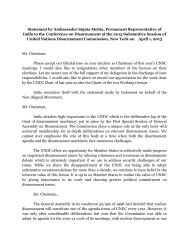
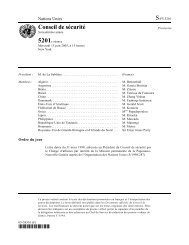
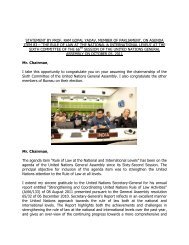
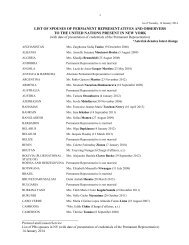
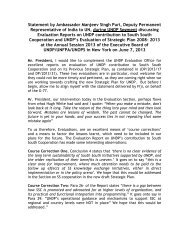

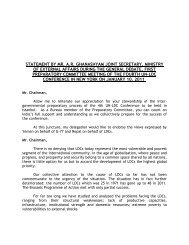


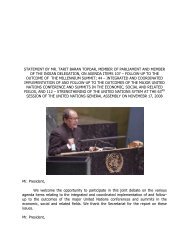
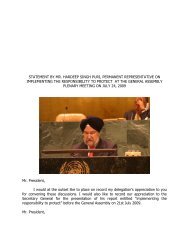
![1 statement by dr.[mrs] kakoli ghosh dastidar - Member States Portal](https://img.yumpu.com/27526598/1/190x245/1-statement-by-drmrs-kakoli-ghosh-dastidar-member-states-portal.jpg?quality=85)
